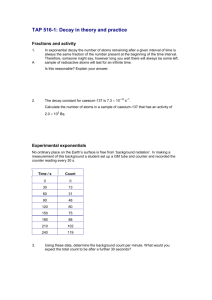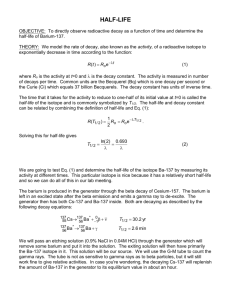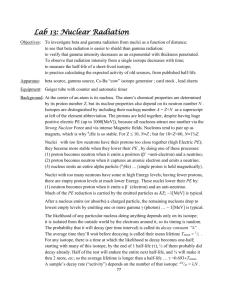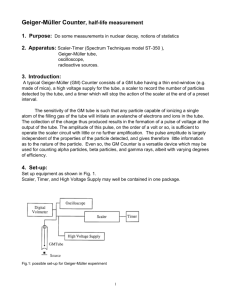27-RadioAct
advertisement
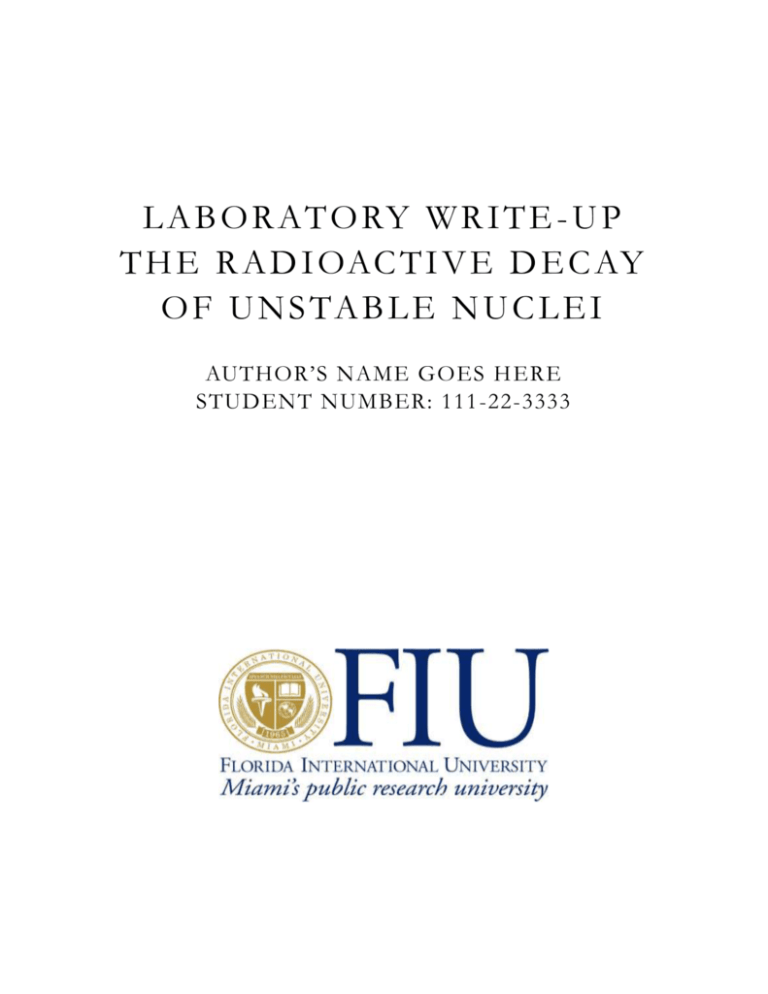
L A B O R AT O RY W R I T E - U P T H E R A D I OAC T I V E D E C AY O F U N S TA B L E N U C L E I AUTHOR’S NAME GOES H ERE STUDENT NUMBER: 111 -22-3333 R A D I OA C T I V E D E C AY O F U NS TA BL E NU CLE I 1 . P U R P OS E The purpose of this experiment is to demonstrate the law governing the decay of unstable nuclei and to measure the decay constant and half-life of a particular nuclide. The law is based on the simple assertion that the decay rate of a sample is proportional to the number, N, of unstable nuclei: -dN/dt = N , where is the "decay constant". By integrating this expression we obtain the number of parent nuclei as a function of time: N = Noe-t ......................(1) where No is the number of parent nuclei at t = 0. The number of decays, N, in a fixed time interval, t to t+t, is obtained from equation (1): N = N(t) - N(t+t) = Noe-t(1 - e-t). ln N = -t + constant ..............(2) The "half-life", T1/2, of a radioactive material is the time it takes for half the parent nuclei to decay. Thus from equation (1) No/2 = Noe-T1/2 from which T1/2 = 0.693/ ...................(3) For the experiment, you are provided with a sealed Teflon tube containing a 10% acidic solution of uranyl nitrate and a small amount of a lighter immiscible liquid which is a 5% xylene solution of triisooctylamine. The uranium isotope, 238U, as a nitrate salt, is the starting point of a decay sequence with the following initial stages: U 234Th 4.5x109 yrs 24.1 days 238 Pa 234U 230Th 1.18 mins 2.5x105 yrs 234 The decay stage from protactinium 234Pa to uranium 234U, with a half-life of 1.18 minutes, is exploited in this experiment. When the tube is shaken, the protactinium ends up in the 2 lighter xylene layer. A Geiger tube placed close to this layer will respond almost exclusively to the -particles emitted as the protactinium decays. 2 . P R OC E D U R E Since the half-life of protactinium is so short, you need to be thoroughly familiar with what is required before shaking the tube and thereby starting the experiment. The following should be read carefully before proceeding. Identify the white Teflon tube containing the radioactive liquid. Carefully remove the lid and note the thin Mylar film, which seals the tube. THIS FILM HAS A HIGH TENSILE STRENGTH BUT COULD VERY EASILY BE PUNCTURED BY A SHARP OBJECT. Connect the Geiger tube to the counter and set the latter for 30 second counts. Check that it is functioning correctly by obtaining counts from the small radioactive source provided. Place the Teflon tube on the bench, Mylar film uppermost, and arrange the Geiger tube vertically above it with its end window almost in contact. You will be required to take 30 second counts at one minute intervals, i.e. there will be a 30 second interval between the end of one counting period and the beginning of the next. For greatest accuracy, a stopwatch should be left running continuously. Remove the Teflon tube from underneath the Geiger tube, replace the lid and, holding the lid in place, shake the tube vigorously for about 10 seconds. Replace it underneath the Geiger tube. As soon as the xylene layer has separated out, begin taking the 30 second counts and continue until the number of counts appears to have leveled off. Wait for 10 minutes and then obtain a 5 minute count. Use this latter result to calculate an average 30 second background count and subtract this average from each of your previous counts to obtain true counts. 3 . C A L C U L A T I ON S Plot a graph of true counts per 30 seconds as a function of the time at the start of each counting period. Put t = 0 as the starting time for the first period. Also plot a suitable graph to obtain the decay constant, , and from this determine the half-life of the protactinium isotope. 3



